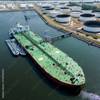Just after 10 o'clock on a Tuesday morning in July the call came that a car had rolled off Randall's Island into the East River. Chief Bill Siegel, at his desk at Marine Division Headquarters in the Brooklyn Navy Yard, paused for just an instant then jumped up, grabbed a life jacket and headed for the stairs. Other firefighters were already on their way to the pier where the Kevin C. Kane, was tied up waiting to go. Within four minutes the 52-ft. boat was underway with its five-person crew racing upriver toward the sinking car. The men moved swiftly, yet calmly to set the stern deck pipe to pump water in an effort to gain an extra knot or two of speed.
Seventy years ago, fireboats ruled New York Harbor. Much has changed since the first half of the 20th century when the more than 430 sq. mi. of water were lined with about 1,800 wooden piers that accommodated thousands of ships. Charged with protecting the active commercial center, fireboats extinguished shipboard and pier fires, managed oil spills and performed boat rescues.
But as waterfront businesses declined, so did the need for fireboats. In the late sixties and early seventies the City imposed budget cuts on the Fire Department of New York City (FDNY) and the Marine Division was substantially reduced; five of the nine Marine Companies were disbanded.
Nowadays, with less commercial traffic and more passengers on ferries, dinner cruises and privately owned pleasure craft, the Marine Division responds most often to minor fire and water rescue calls. In June alone, Kane, the workhorse of the Marine Division, responded to 37 calls including a Jet Ski accident, a pleasure boat collision with a rock, and a cabin fire on a 42-ft. privately owned vessel. Last year the boat clocked 818 hours in operation and logged 459 responses. While major fires still occur in lumberyards, container ports, and petro-chemical facilities in isolated parts of the port, smaller pleasure craft accidents, collisions, and fires make up the bulk of the everyday calls.
The changing face of the waterfront has led to a whittling of the fleet from more than a dozen active boats to its current four: Kane (52 x 16 x 4.5-ft.; 6,500 gpm) built in 1992; Fire Fighter (134 x 32 x 9-ft.; 20,000 gpm), built in 1938; John D. McKean (129 x 30 x 9-ft.; 19,000 gpm) built in 1954; and Smoke II (52 x 14 x 4-ft.; 2,000 gpm) built in 1958. The fleet also includes Governor Alfred E. Smith (105.5 x 27 x 9-ft.; 8,000 gpm) built in 1961, which is currently on reserve, and several 25-ft. auxiliary boats that assist the larger boats or serve as command stations for chiefs.
Often called the "redheaded stepchild of the fire department," the Marine Division has been the butt of countless jokes by fellow fire fighters. Yet just a year ago fireboats responded to the largest emergency call in U.S. history and provided what no land crew could: water. From their berth at Pier 53 on Bloomfield Street in Manhattan, the crew of the McKean watched as the first plane hit the World Trade Center. They fired up engines and headed south, evacuating approximately 150 injured people to a triage center at Liberty State Park in New Jersey before tying up to pump what would turn out to be 104 million gallons of water in the 386 hours the boat was stationed onsite. Marine Company 6 was next to respond, sending the Smoke II because the Kane was headed into the shop for a shaft realignment. The Smoke II evacuated passengers then pumped three million gallons of water in 110 hours. Meanwhile the Marine Division shop mechanics quickly reassembled the Kane and put her back into service to pump 21 million gallons in her 244 hours onsite. Fire Fighter was stationed just north of Staten Island, at the ready in case of another emergency, until she was sent to the sea wall near North Cove where she spent 255 hours and pumped 91 million gallons of water. Also tied up just south of North Cove was privately-owned retired New York City fireboat John J. Harvey (built in 1931; 130 x 28 x 9-ft.; 18,000 gpm), which had been called back into service to pump for three straight days. The need was urgent. When I-beams from the towers penetrated the pavement they destroyed water mains, rendering hydrants useless. Early on, river water supplied by fireboats was the only water available to fight the blazes.
"Nine-eleven woke everybody up," said Siegel. "It reminded everybody of the need for a water supply from the Marine Division rather than relying on the hydrant system." Suddenly New York City once again relied on the fireboats. Questions remain whether the City had provided sufficient maintenance resources for them to perform at their best during the emergency no one could have predicted. Many on-site boat repairs were, in fact, necessary while pumping was underway. Since then a renewed sense of urgency seems to have moved fireboat maintenance up on FDNY's priority list.
"After 9/11, everyone was reminded of how important it is to maintain the fleet," said Siegel. "The budget people been very helpful since 9/11." Recent investments in the Marine Division have included modifications, repairs and additional training. The most significant modification was outfitting the deck guns on the Fire Fighter, McKean, and Smith with threaded nozzles to allow foam cannon operation from any monitor. Extensive repairs on those three boats have also been necessary, in large part due to the extended time the boats performed at the trade center, according to Siegel. Repairs since September have included polishing the shaft on one engine and overhauling the pumps on the Fire Fighter, pump overhaul and replacement of exhaust manifolds on all four engines of the McKean, and replacing the head gaskets and cylinder liners on the Smith. In addition, the Kane was recently repowered with two new 3406E Caterpillar propulsion engines.
FDNY has also spent money on training, sending 20 firefighters and officers to Norfolk, Va., for a week of shipboard firefighting training. The 20 were also certified as instructors and will be expected to teach other fire fighters what they learned. Siegel's goal is to ensure that "every probie [new recruit] will be exposed to shipboard firefighting training."
The fireboats' contribution at the World Trade Center set a new tone for the importance of the Marine Division. But another change further emphasized the need: increased passenger traffic on the waterways. Over the past year ferry operators have added routes to accommodate commuters who can no longer take PATH trains from Lower Manhattan to New Jersey. Today, all types of boats make 2,000 trips across the Hudson River, carrying 66,000 commuters every weekday. Protecting those passengers is a big job and one part of meeting the greater need is bulking up the Marine Division fleet with two new boats.
Despite the fact that a letter of intent has been sent to Eastern Shipbuilding Company in Panama City, Fla., for the purchase of two new 85-ft. boats, design details are hard to come by. After the fiasco of the last purchase, FDNY remains decidedly reticent about its plans for the new boats. In 1992 two fast, shallow draft fireboats were delivered at a cost of $3.5 million each. The 70-ft. surface effect vessels were designed with a protected space between glass-reinforced plastic catamaran hulls that could be pressurized with air, lifting the craft and reducing resistance. Though they were rated at 30 knots with a pumping capacity of 7,075 gpm, the boats were in service for only two years before being returned to manufacturer Textron Marine in late 2001. According to several Marine Division sources who declined to give their names, the boats were completely impractical. A short run around the harbor would require seven or eight hours of maintenance to follow, said one mechanic. "The pilot's station looked like an airplane cockpit - these men with canned ham hands were trying to press these tiny buttons."
This time around, fire department officials are playing very close to the chest until the contract ink dries. They have disclosed plans to pay Virginia consulting firm Rosenblatt & Son half a million dollars to oversee construction. Siegel was, however, able to share some features he hopes to see including a triage area for first aid and space to transport passengers out of the weather. The main goal for the new boats will likely be speed, said Siegel. "In a city so large, with fewer berths available, speed is a high priority."
While waiting for final word on the new boats, Siegel's main task is to make sure existing boats stay in good working condition. To demonstrate that the Marine Division is alive and well after last year's trials, he organized the first annual Blessing of the Fleet which took place on a morning in late July. Led by Fire Fighter, the procession of all eight boats filed past a review stand at Pier 17's South Street Seaport, where a priest stood waiting. Intended to promote pride in and respect for the Marine Division, Siegel said he hoped the ceremony would "restore everybody's faith that the Marine Division is back on its feet and running - that we're in good shape despite all that's happened."
Meanwhile crews continue the day-to-day work of fire and rescue operations. This sometimes includes rushing to the scene of a car in the water only to be turned back mid-run.
Despite the extra two knots gained by engaging the stern deck pipe, the Kane was interrupted before reaching Randall's Island by a call from Marine Company 4, a 25-foot whaler stationed in the Bronx, which also responded. FDNY divers had confirmed there was no one in the vehicle. With no water rescue needed, Kane turned around and headed back to the yard to await the next call.
Sponsored Content
Innovative Hull Maintenance: Profitable & Green

Subscribe for
Maritime Reporter E-News
Maritime Reporter E-News is the maritime industry's largest circulation and most authoritative ENews Service, delivered to your Email five times per week













